When Kawasaki launched the Kawasaki Z900RS, certain journals mentioned that it had design elements that hearkened back to the “Eddie Lawson Replicas” of former times, starting with the Z1 a very long time ago.
Being not that old (but no spring chicken), Eddie Lawson wasn’t a familiar name to me. So I thought: who is this Eddie Lawson? Why are there motorcycles built to replicate his bike (or perhaps him, like a Madame Tussauds wax figurine perhaps)? And what were these mythical bikes?
This is everything I found out — how the Eddie Lawson replica motorcycles originated, and how they brought us to the Kawasaki Z900RS (which isn’t quite the same thing, but which draws some relevant inspiration) today.
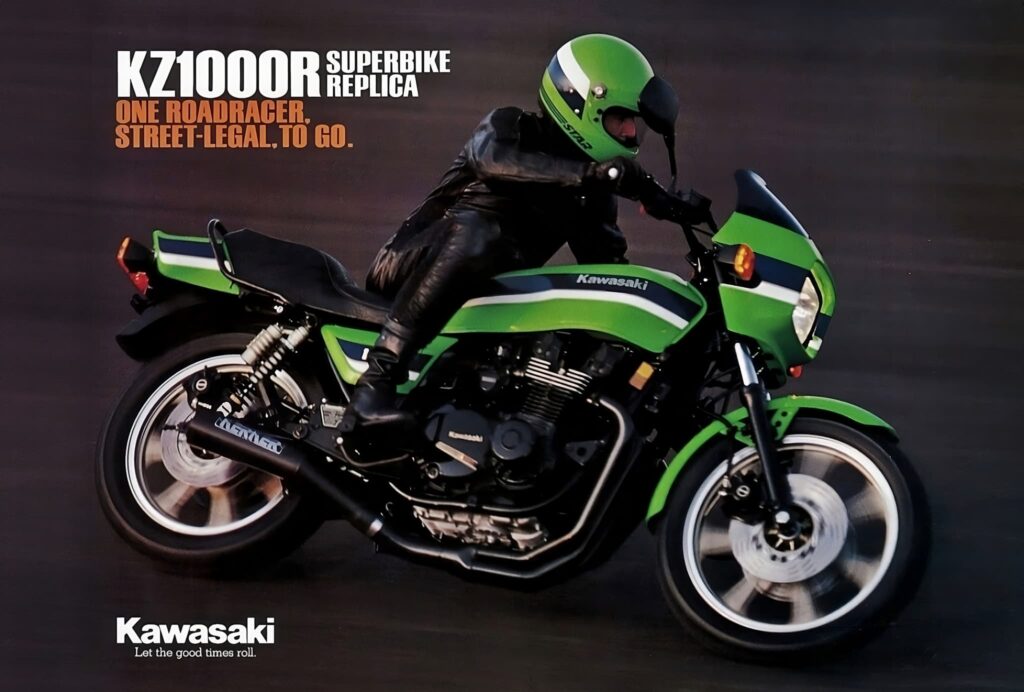
There are certain facts in life we accept as being true by virtue of themselves. English is the most widely spoken language in the world. Humans need oxygen to live. Kawasaki motorcycles are green. (Well, many of them are.)
Kawasaki motorcycles have been the “green” brand for longer than I have been alive. And that’s an increasingly long time.
Whether the association was an intentional branding decision against its major competitors — Honda’s red, Yamaha’s blue and Suzuki’s… also blue? — or just something that happened over the passage of time, I’m not sure.
But the association between the colour green and Kawasaki is strong, and is extremely evident in one of Kawasaki’s most well-known legacy of motorcycles: the Eddie Lawson Replicas, and the bikes inspired by this line.
The Eddie Lawson Replicas are a series of road racing motorcycles. These motorcycles defined Kawasaki’s racing brand — and to my eye, their aesthetic image — like no other motorcycle. This was the series modelled after the motorcycle that Kawasaki’s in-house racer, Eddie Lawson, rode to superbike history in 1982: the KZ1000R.
The KZ1000R itself came into existence in part thanks to the legacy left by the first great Kawasaki big four, the Z1. After Eddie Lawson rode to victory, first came the replica of his KZ1000R, then the ZRX1100 built in its image over a decade later, then the improved ZRX1200R, and finally the recent Z900RS.
Each of these “Eddie Lawson” motorcycles is stunning and a piece of history. Let’s examine them one by one.
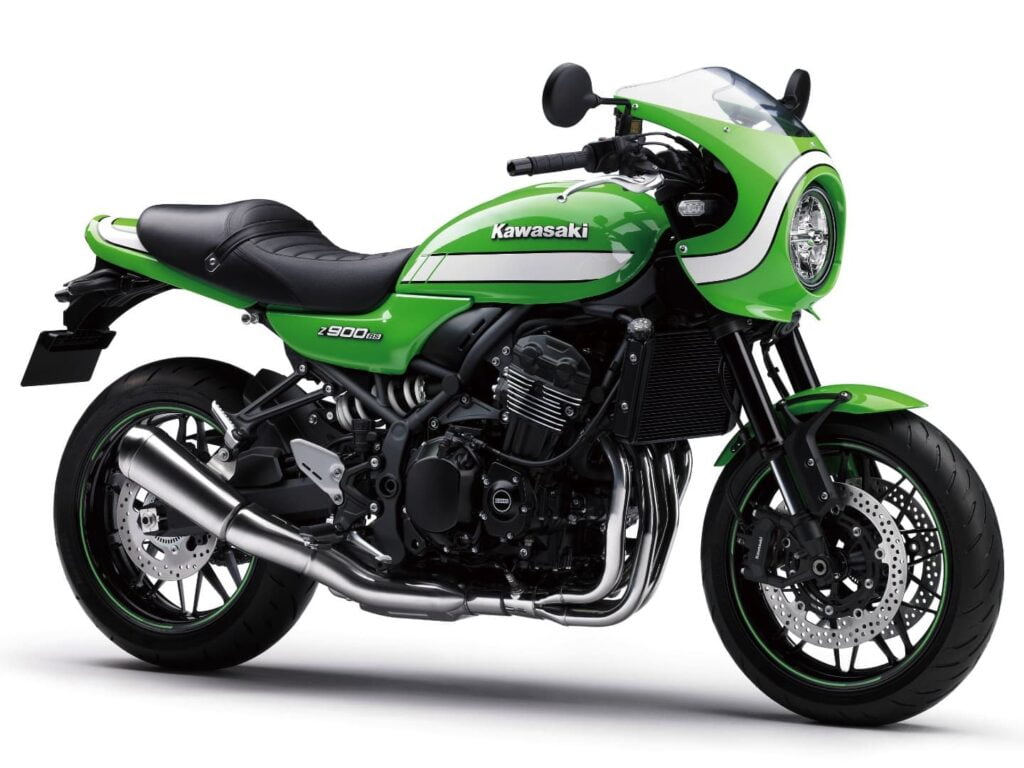
Are you obsessed with motorcycles?
Well, I am. That’s why I created this site — as an outlet. I love learning and sharing what others might find useful. If you like what you read here, and you’re a fraction as obsessed as I am, you might like to know when I’ve published more. (Check the latest for an idea of what you’ll see.)
The Predecessor to the Eddie Lawson Replica: The Kawasaki Z1
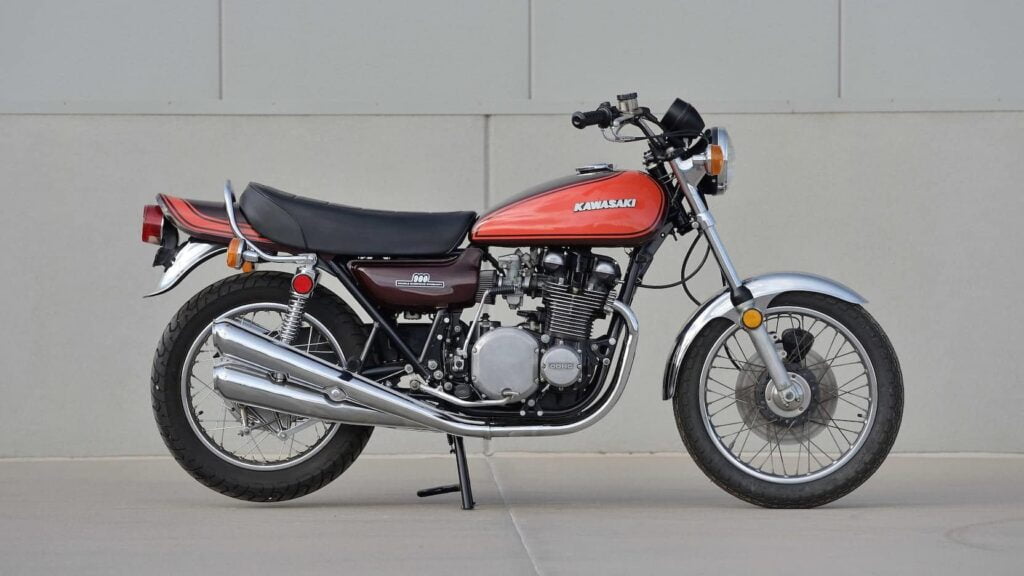
The Kawasaki Z1 was where it all started for Kawasaki. It was the beginning of a new age. The Z1 was commissioned by Green HQ as a 750cc in 1967.
Then in 1968, Honda released the iconic CB750, changing history. A fast four! Upright! Decades later, the CB750 is still a favourite of motorcycle builders and collectors (though they’re in dwindling supply… and redefined by the Honda CB750 Hornet).
When Honda released the CB750, Kawasaki went into disarray. They couldn’t release an identical capacity bike! They went back and retooled to later release the larger-capacity 903 cc Z1 in 1972.
If I were there, I’d have chastised them (because I’m so influential as a writer and sometimes corporate strategist). There’s nothing wrong with releasing a motorcycle just like a competitor. Product releases can’t and shouldn’t be delayed by years in today’s cut-throat environment — but that was a different time, before the age of private equity, sky-high equity expectations, and leverage. Consumer product cycles were slower.
In retrospect, you can argue that Kawasaki made the right decision. Kawasaki, by delaying release of the Z1, chose its own destiny and brand identity.
The Kawasaki Z1, when released, was a thing of beauty and entirely unique for its time, notable for using a double overhead cam shaft in a production motorcycle, the first to do this at reasonable cost (i.e. not an MV Agusta).
Together with the CB750, the Z1 helped popularise upright inline-four motorcycles, paving the way for a slew of motorcycles becoming known as UJMs (“Universal Japanese Machines”) in the 1980s.
I haven’t ridden a Z1 myself, but people who did own them regret selling them. They were very fast for their time. If you want one these days you’ll want one properly restored, usually with upgraded suspension reflecting modern demands. And you’ll pay a lot.
If you’re still looking for a Z1, you’ll have to buy from a restorer. Try the Z1 Forums in the US, or setup a watcher on eBay. They show up but are priced to reflect the effort put into restoring them.
The Original “Eddie Lawson Replica”: The Kawasaki KZ1000R (1982-3)
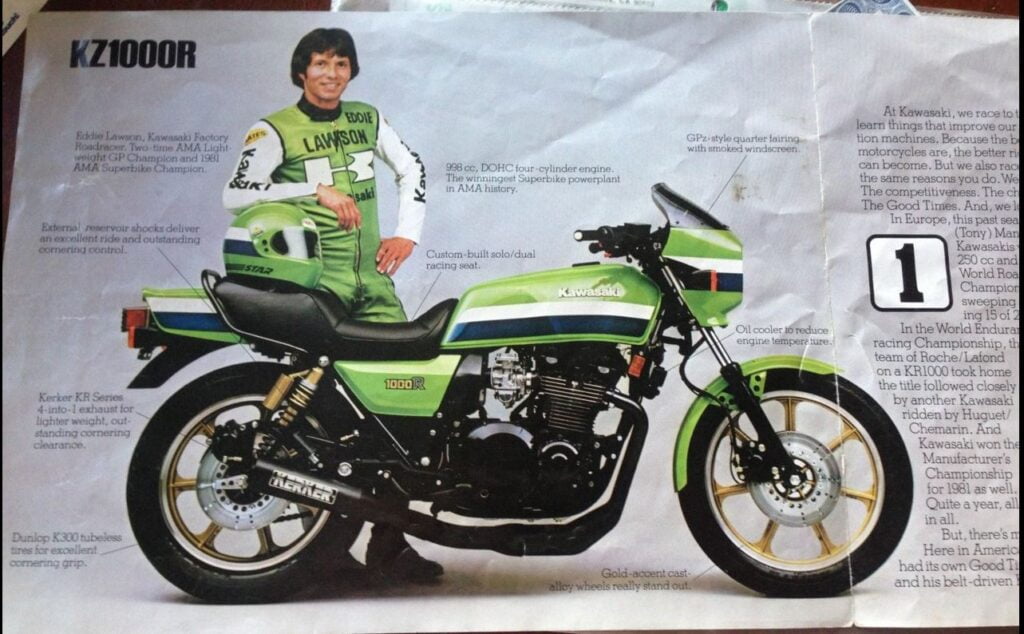
Motorcycle racing rules changed in the early eighties, introducing the Superbike class. Basically, huge motorcycles. This created a sudden vacuum into which Kawasaki confidently strode with its KZ1000R, a huge 998 cc four-cylinder motorcycle that was going to help redefine history.
Eddie Lawson, Kawasaki’s in-house racer, rode a modified Kawasaki KZ1000R to Superbike victory in 1982, giving way to a legendary design that would bear his name as the “Eddie Lawson Replicas” for decades to come.
It was a worthwhile name to bear: Eddie Lawson was one of the greatest racers of all time. He won the 500cc World Championships four times in the 1980s. When he retired from Grand Prix racing he ranked third of all time with 31 victories.
The Eddie Lawson Replica (“ELR”) Kawasaki KZ1000R was the same as the base model KZ1000R, but modified to be like the one that Eddie Lawson rode. This meant it got:
- A special Kerker exhaust,
- Adjustable rear suspension, and
- (critically) A striking green paint job to replicate the one Eddie Lawson rode.
The original KZ1000R was popular enough (it was even a police bike in some places!) but the green one was the truly beautiful one.
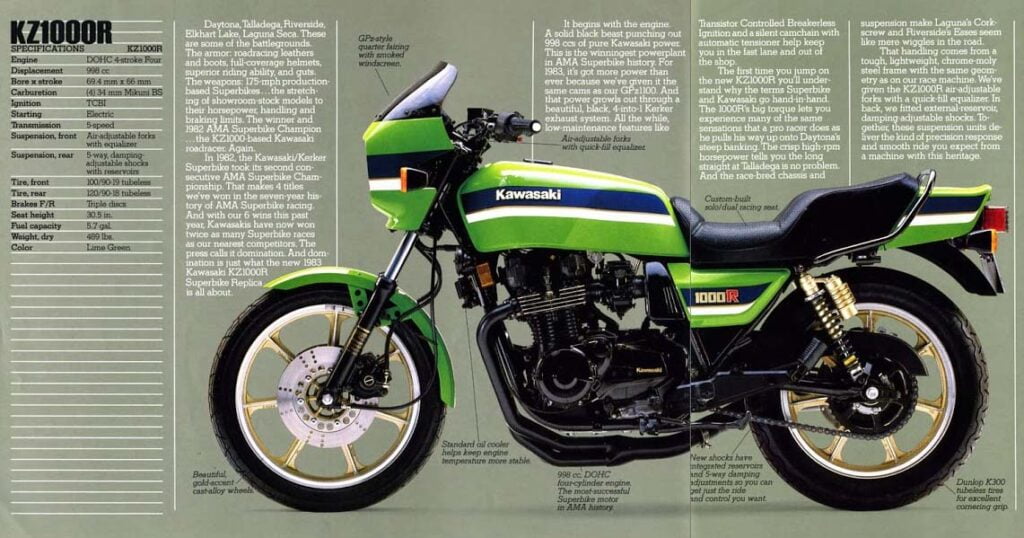
Kawasaki made the Eddie Lawson Replica model only in 1982 and 1983 and in limited quantities of 750 total. People around the internet often lament having sold them because they’ve gone up in price quite a lot! Not matching inflation, so if they sold them to buy Apple stocks that would have been a much better idea, but still, it’s rare for a motorcycle’s value to go anywhere but down.
The standard Kawasaki KZ1000R produced around 80 hp at production, and the modified Eddie Lawson Replica turned that up to a more respectable 102hp. It’s not much to carry around the 500 lb+ wet weight, but who’d be riding around a collector’s item like this, other than to shows?
The KZ1000R Eddie Lawson Replica is now a collector’s motorcycle and is effectively unavailable outside fancy vehicle auctions where it’ll cost a lot more than its technically more capable successors.
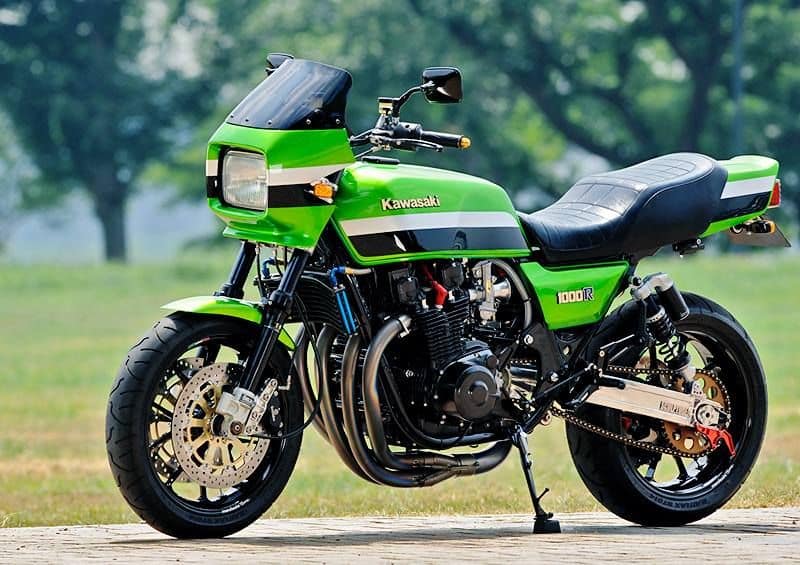
The second Eddie Lawson Replica: The ZRX1100 (1997-2001)

In the late nineties, naked motorcycles started becoming popular, on the back of the success of the Ducati Monster. These naked motorcycles slightly redefined the UJM “standard” theme.
How were “naked” motorcycles of the nineties different from the “standard” motorcycles of the eighties? The handlebars were lower, engines were more powerful, suspension firmer and they were overall slightly faster.
Anyway, the ZRX1100 was built as a homage to the Eddie Lawson Replica. Yes, it was also sold in black and other colours, but who cares, we’re here for the green one!
The Kawasaki ZRX1100 was made from 1997-2001 and sold in the US only from 1999. The US has long been a tough market for Japanese bikes with more niche appeal, like big-bore inline four-cylinder bikes (e.g. the XJR1300).
The 1052cc engine of the ZRX1100 cranked out 72 kW (96 hp) and 94 Nm (69 lbf-ft), which was fine, but really isn’t that much considering the combination of the heavy steel frame and engine that put this motorcycle over 550 lb / 250 kg wet. The engine came from sportbikes (the ZX-11) but was re-tuned for more mid-range. Few people will throw these around at the 200+ km/h that they can do.
The torque for the ZRX1100 comes on low, reaching near peak levels around 3,500 RPM and staying there until close to the redline. Opening up the exhaust and intake and re0tuning it does wonders — I’ve read reports of horsepower and torque numbers being sent up by 25% without much difficulty.
You can still easily buy a Kawasaki ZRX1100 on Craigslist in the USA. They’re rarer in Europe and Australia, but they’re around.
The Third Eddie Lawson Replica: The ZRX1200R (2001-2007)
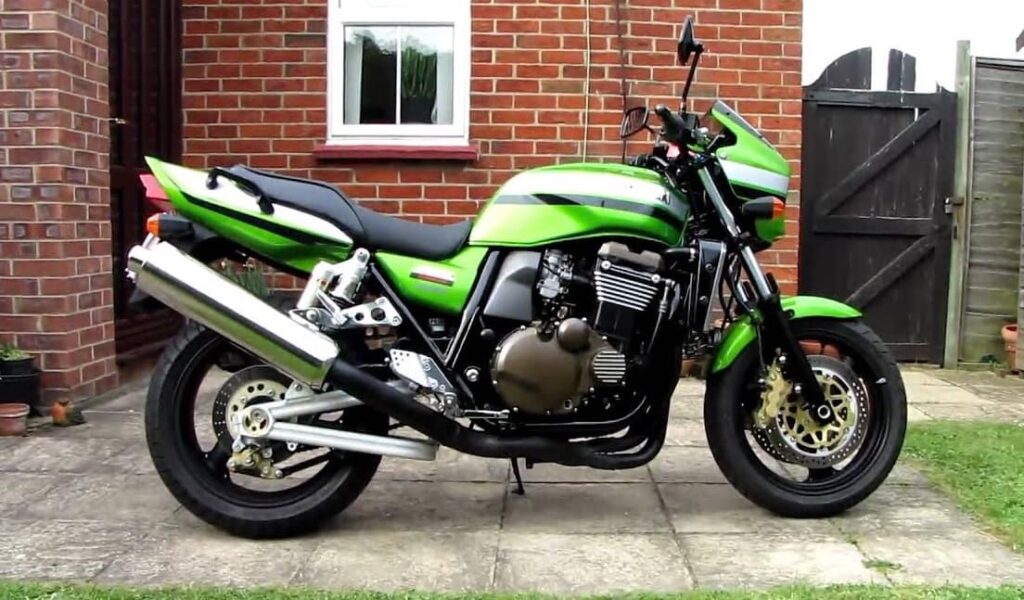
- Engine: Inline four cylinder, dual overhead cam, 1,164cc, carburettor-fed
- Power: 91 kW (122 hp)
- Torque: 109 Nm (81 ft-lb)
Kawasaki built on the success of the ZRX1100 to release the ZRX1200R and made some huge improvements to make it really sing. It was sold in Japan from 2001-2007, but in the US it was only sold until 2005.
Worldwide, there were three variations on the ZRX1200 – R, S, and N — but the ZRX1200R was most common in the US, and one of the most popular models today. I’ve seen a few S models rebuilt as R models.
Kawasaki increased the engine capacity to 1,164cc, increasing the power 91 kW (122 hp) with 109 Nm (81 lbf-ft) of torque. Again, torque comes on early, and this can easily pull in top gear from around 50 km/h (30mph). Fuel is delivered by four carburettors. Unlike its contemporary competitors (the Yamaha XJR1300 and Suzuki GSX1400), this motorcycle never got fuel injection.
And unlike most sportbikes, the Kawasaki ZRX1200R has handlebars. This is no cafe racer with clip-ons. The position is lower than most “standards”, though.
The Kawasaki ZRX1200Rs received huge critical acclaim, and not just because of the way they look. They were often the favourite when compared to similar motorcycles of the era — mostly not available in the US.
The only criticism of the ZRX1200R was soft suspension (a criticism I read of nearly every motorcycle, honestly, possibly indicating a disjuncture between journalists and everyday riders), which is easily rectified with a few simple modifications, including better springs, gold valve emulators and heavier oil (or just fresh oil! this is no spring chicken), and just a better pair of rear shocks.
Like many motorcycles, the ZRX1200R sounds like a lawnmower stock, so I wouldn’t buy one unless it had an exhaust fitted, which is an expensive and hard-to-find part these days.
The Kerker aftermarket exhaust is a favourite balance of performance and sound. Make sure it also comes with a rejetted carburettor.
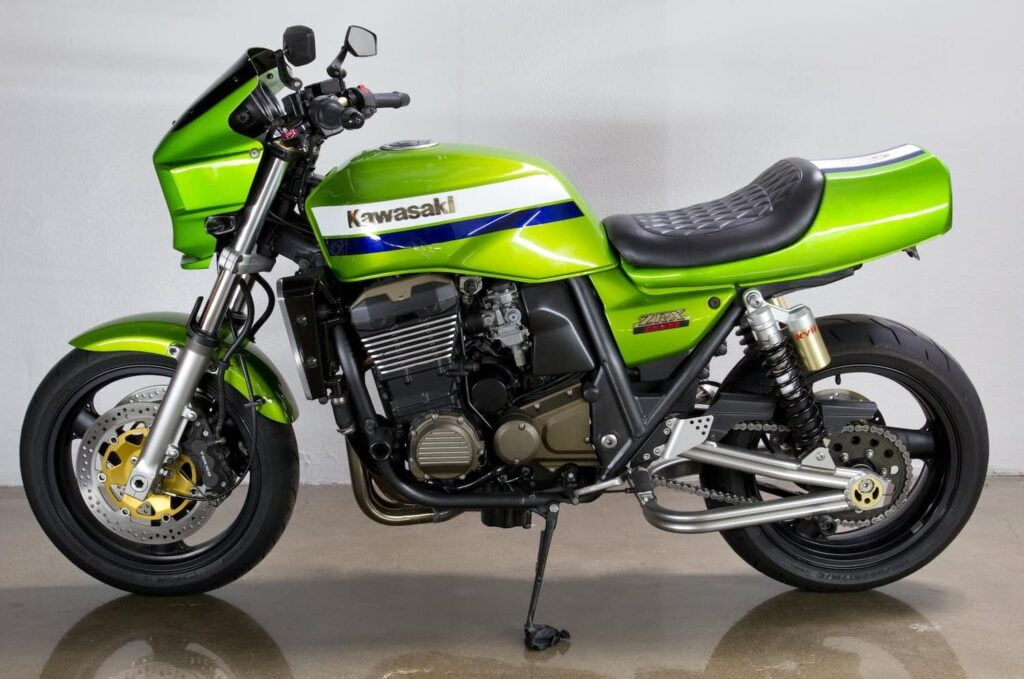
You can still get the Kawasaki ZRX1200R in the USA, Australia, and Europe. There are usually a few hanging around on Craigslist in the major cities. Unfortunately, most of them are relatively high mileage (50K miles is quite common), and green is rare and will cost you an extra $1000 or more. I saw a green one go in San Francisco for $4,000 in 2018, and it sold within hours of being listed. They’re special.
In every market, people who own ZRX1200Rs know they’re special and collectible and will charge a slight premium for them considering their age, particularly if they’re well-maintained. There’s nothing wrong with this — but when you’re paying US$4-5K for a bike, just be aware of all the other bikes you may not be getting for the price.
The Japan-only ZRX1200 DAEG (2008-2016)
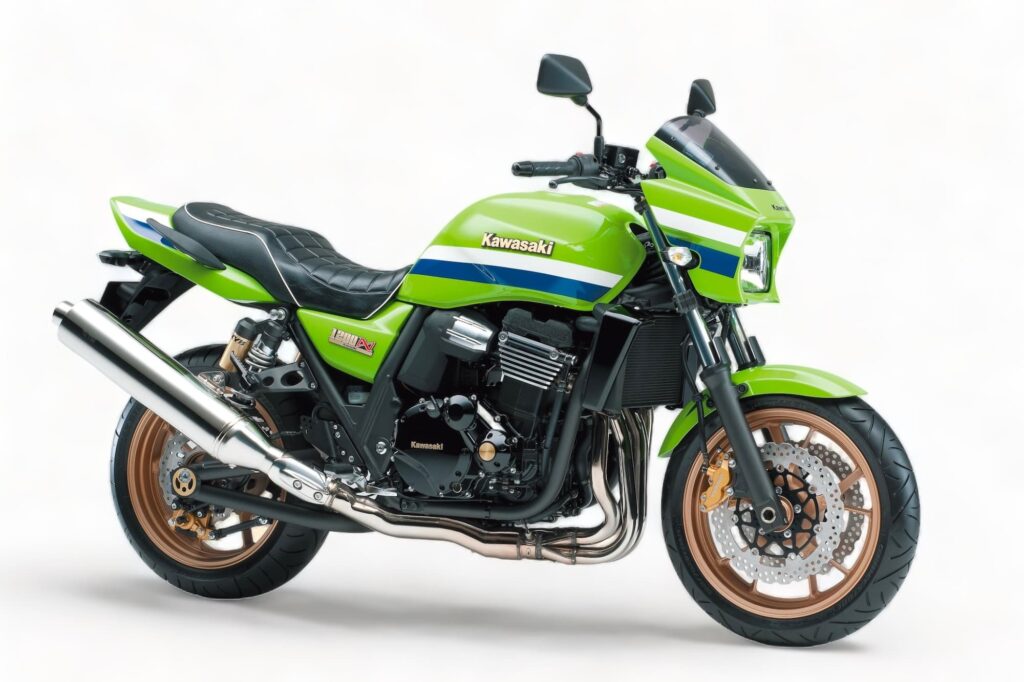
In 2008, the ZRX1200 was updated with fuel injection. Kawasaki also decided to stop exporting them outside Japan for economic reasons that make me really mad.
The name DAEG stems from a rune, which is shown in a “ᛞ” logo on the side of the motorcycle. If that doesn’t show on your screen, it looks a bit like a square infinity symbol — see the image below.
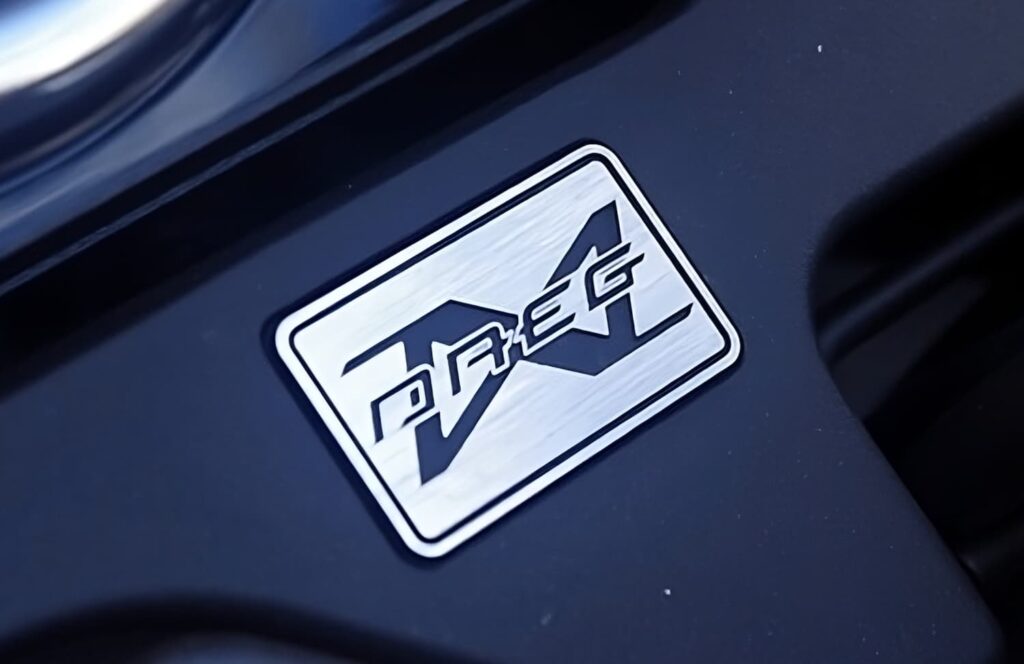
In Japanese it’s pronounced “da-e-gu” (ダエグ), though it’s not a Japanese word. In English it’s safe to pronounce it “da-eg”. The word / rune means “day” and is the etymological root of the same word in English, via Old English. Here’s more about the rune itself.
Kawasaki uses it to mean “progress”, “evolution”, or “taking a leap”. They only ever used it with the ZRX1200R Japan-only model. (Source: Kawasaki.)
Kawasaki made significant changes to the ZRX1200R DAEG that, in US trim, would have provided an increase in performance not only from the engine, but from the braking system and the chassis.
The new ZRX finally got fuel injection, along with porting and valve work in the engine department, a new exhaust system and a six-speed transmission (the old bike was a five-speed). They added new Tokico four-piston brakes squeezing a pair of petal-shaped front rotors measuring 310mm and a single piston/250mm rotor combo in back.
They also improved the steering geometry, suspension and swingarm. Apparently, this was to better suit the Japanese domestic market. Dang! I have half a mind to import one.
The ZRX1200 DAEG ended production in 2016, with tightening global emissions standards killing it off.
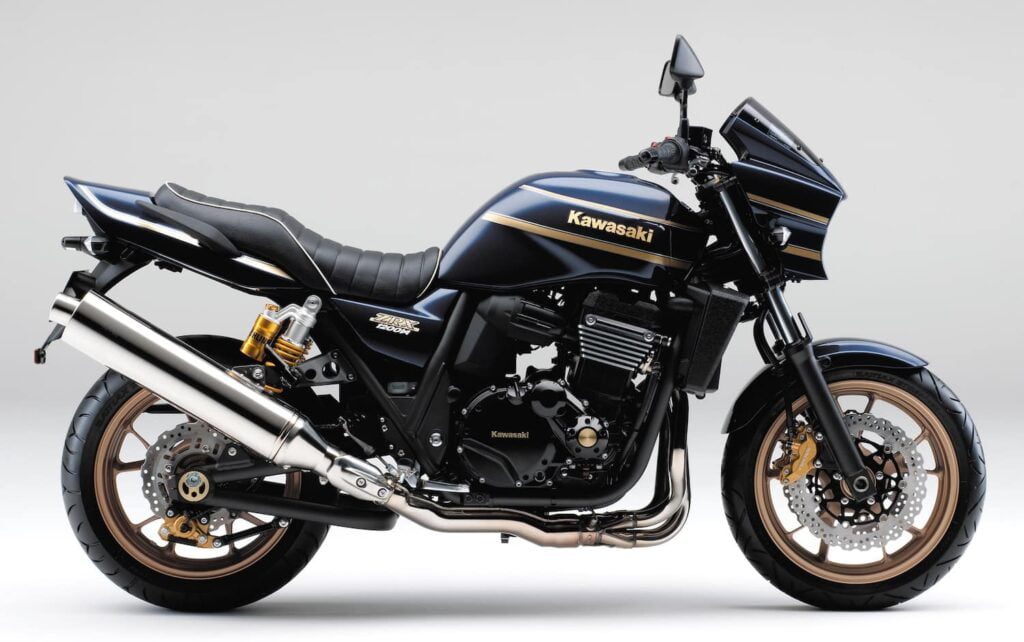
Kawasaki finally ended the ZRX1200R DAEG with a final edition in 2016.

The Kawasaki Z900RS Café (2018-present): The Modern Classic
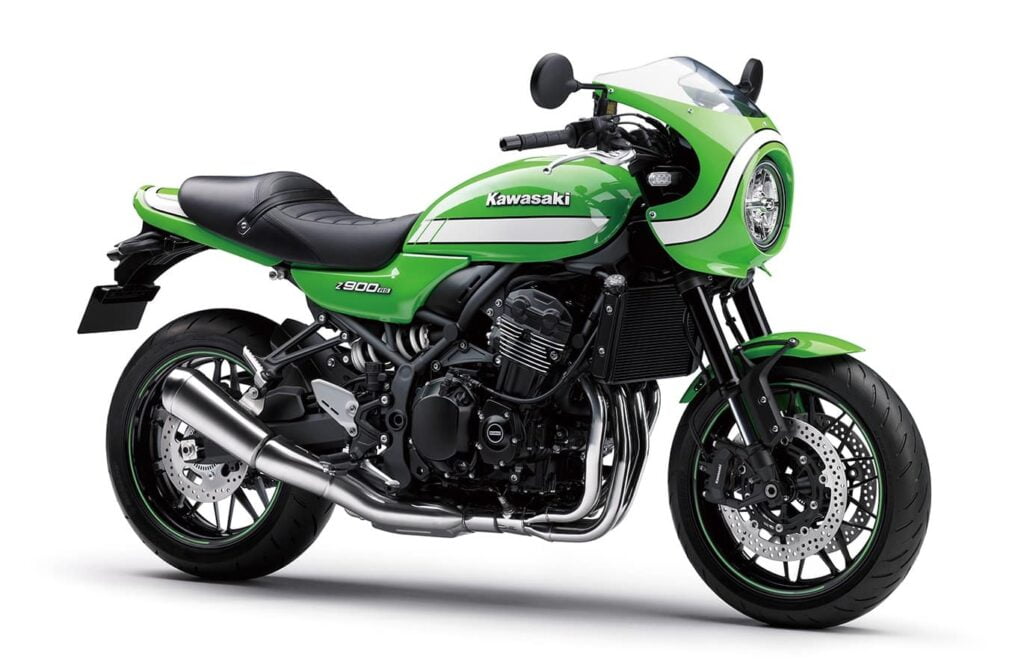
In 2017, Kawasaki released its most modern incarnation of Kawasaki four-cylinder motorcycles: the Kawasaki Z900RS.
To be clear, this is no longer an Eddie Lawson Replica. It doesn’t have the classic boxy lines of the original ELR, nor the ZRX1100R or ZRX1200R. But it has a certain something that hearkens back to that era. Plus, it’s more available than those aging, appreciating classics.
The Z900RS got a great reception from motorcycle journalists and new owners alike. Apart from being beautiful to look at, the Z900RS is amazing to ride. So much so that if I had to buy a new motorcycle this would be one of the leading contenders (and it always is in the mix).
Bikesales in Australia called the Z900RS the “motorcycle of the year”. Cycle World in the US called it the “best-looking motorcycle of the year”. High praise. (Here on this site, I called it one of the best-looking motorcycles of 2019.)
Even the occasionally cantankerous Lemmy of Revzilla liked it: “I like it. I like it a lot. This bike’s going to hit the right notes for a lot of riders, from duffers to serious go-fast riders, second-bike buyers right up to salty old-timers, ages 25 to 75.” In some other place (that I can’t find) he said it was one of his picks for the bike of the year.
The Kawasaki Z900RS’ 948cc engine throws down 82 kW (110 hp), with 98 Nm (73 lbf-ft) of torque maxing out at a relatively high 7700 rpm. It weighs 215 kg (474) wet, which is a bit heavier than liter-bikes, but not much. It’s fairly standard for a … standard.
They actually took the motor from the relatively similar (but more modern-looking) Z900, another standard/naked, but de-tuned the delivery for more low-end grunt. This cost top-end horsepower, but again, why would you take this anywhere near its theoretical top speed? Unless you’re as aerodynamic as a supercar it’d be fairly pointless.
If you’re interested, I did a deep dive into the Z900 vs the Z900RS to look at all the spec differences to help you decide. In short, the Z900 is pretty tantalising if you feel like going faster and saving a third of your money, if you don’t value style as much.
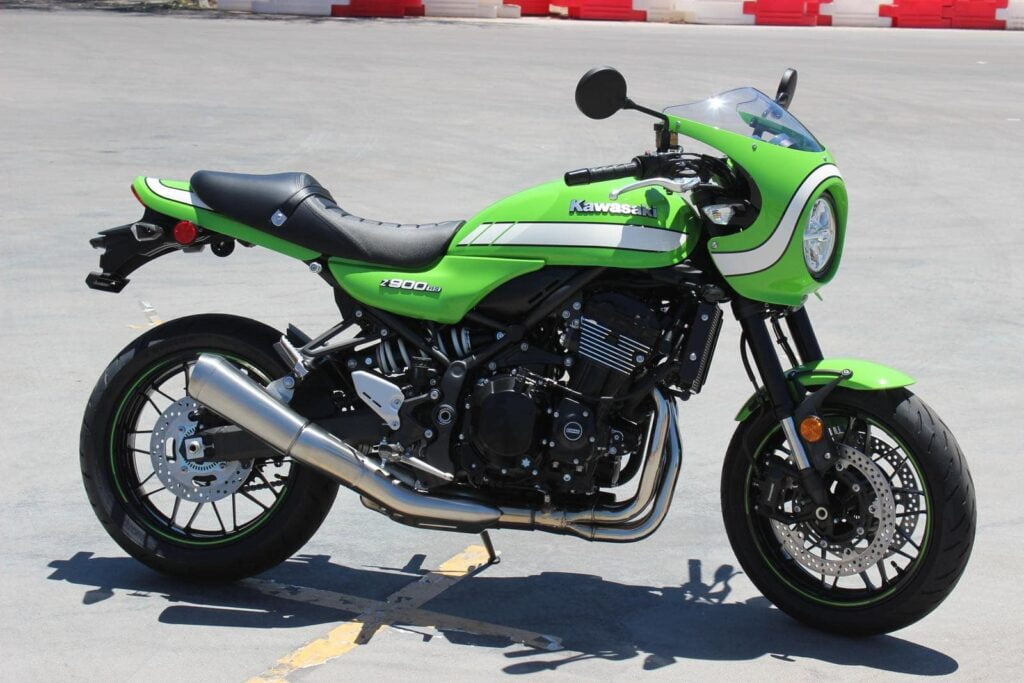
But what’s the Z900RS like to ride? It’s fast. It’s comfortable. It is modern.
The difference between the Z900RS and the ZRX1200R is that the former feels like a modern, revving sports motorcycle, but the latter feels like a heavy standard.
If you buy a ZRX1200R, you’ll probably be buying one with upgraded exhaust, a re-jet of the carburettors, and some upgraded forks. All those are basically necessary to make the motorcycle feel modern, fast motorcycle, but nothing will take away from its weight.
If you get a Z900RS, you’ll pay a lot more of course, but you’ll get all that and a lighter motorcycle.
The only downsides to the Z900RS is that it lacks a little — or a lot — compared to its contemporary competitors. Compared to most modern sport bikes (e.g. the BMW S 1000 R), it’s heavier, less powerful, and doesn’t have niceties like cornering ABS or cruise control.
But that’s not really what the Z900RS is about. It’s meant to be a more easy-going bike, and it relies on aesthetics more than almost anything else.
The Kawasaki Z900RS, especially the green Café variants (there are a few different colour schemes), is undoubtedly a future classic, especially as the Café is gradually being discontinued in various markets.
See is the full list of bikes I think are likely to be future classic motorcycles.
If you need any other reasons to get one, this is it!
Other “Classic” Motorcycle Series
There are a few other series of modern motorcycles that have similar classic status and make us think about the eighties and nineties.
The main one that comes to mind in terms of retro modern bikes is the Suzuki Katana. The Katana is based on the early 1980s motorcycle of the same name. Just like Eddie Lawson Replicas, the original Katana (in 1100 format) is more expensive than the brand new model.
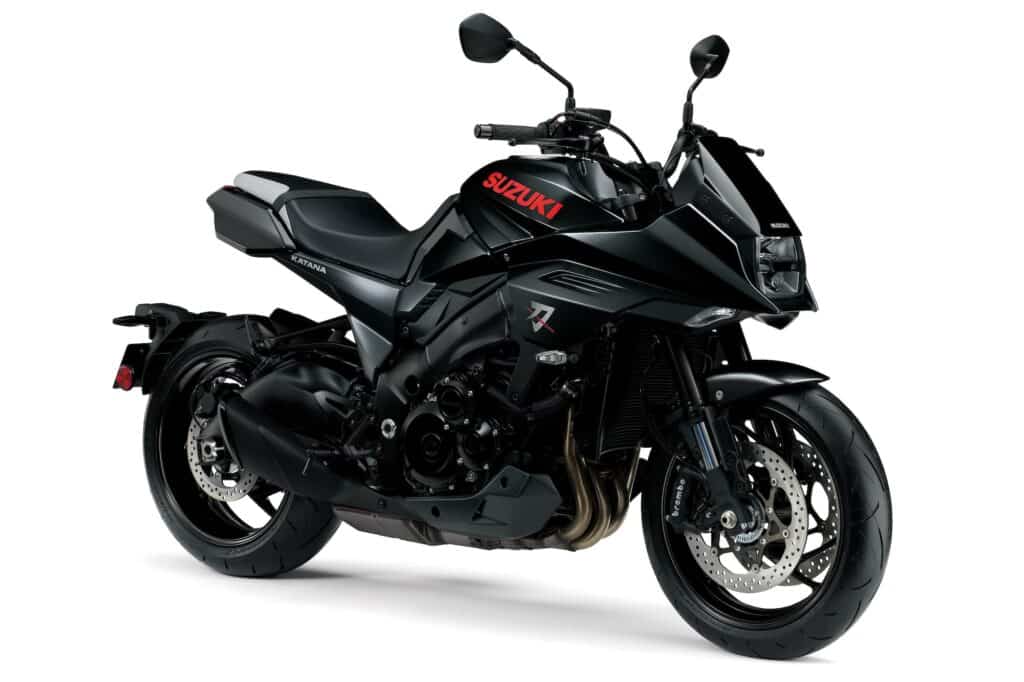
The modern Suzuki Katana is a little lost in today’s world where we’re spoiled for choice in the category of “fast standards”. There’s a bike for everyone — the Yamaha MT-10 if you like a crossplane motor, the BMW S 1000 R if you like a superbike with handlebars, and the Ducati Streetfighter V2 if you want a twin. And there’s more, but you get the point.
Another bike often lost in today’s modern retro line-up is the Honda CB1000R (see this fuller exploration of that bike here).
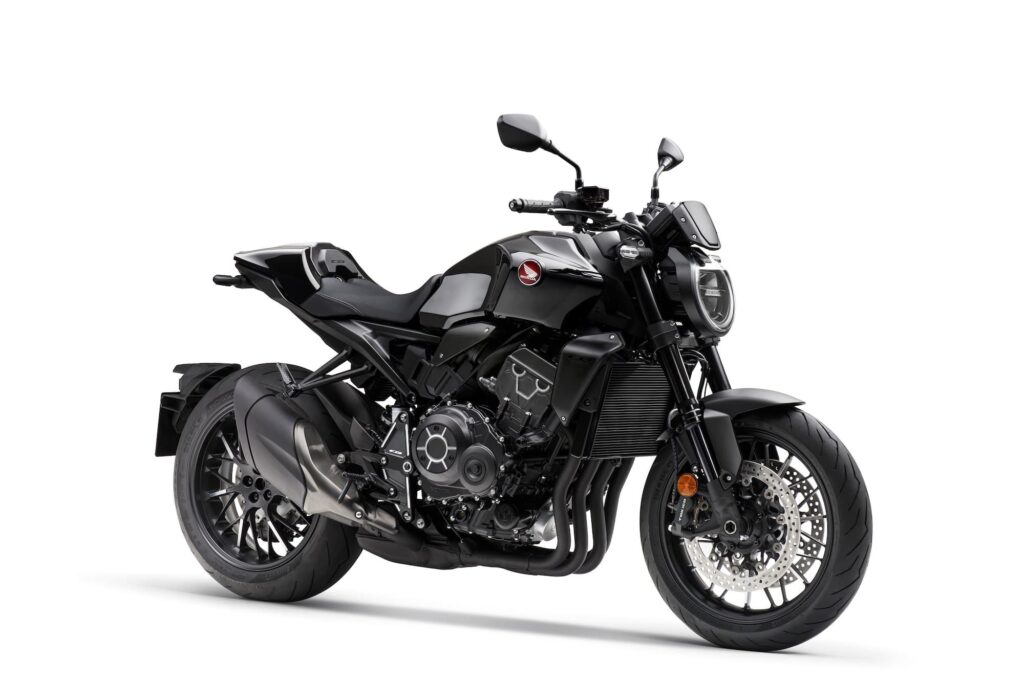
The Honda CB line dates back to the CB750 (mentioned at the beginning of this article), though really the CB1000R reminds me more of the CBs of the 80s which had liquid cooling and more aggressive intentions. The 2018+ “Neo Retro” CB1000R is unmistakably modern, but has a lot of stuff that’s designed to just look cool, like the round front headlight and the single-sided swingarm.
The Ducati Monster is a classic, but it has changed so much since its 1993 incarnation that the new one is completely different in a number of dimensions. And the Yamaha XSR900 looks classic, but it’s not meant to hearken back to any particular bike other than as an idea.
Anyway, whichever way you go, there’s a bike for everyone. But I’ve known enough happy Kawasaki Z900RS riders to know that you’d be unlikely to be disappointed.

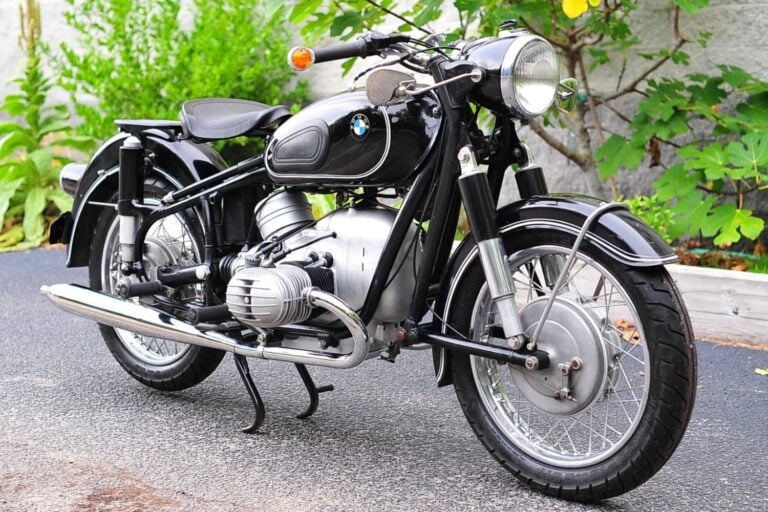
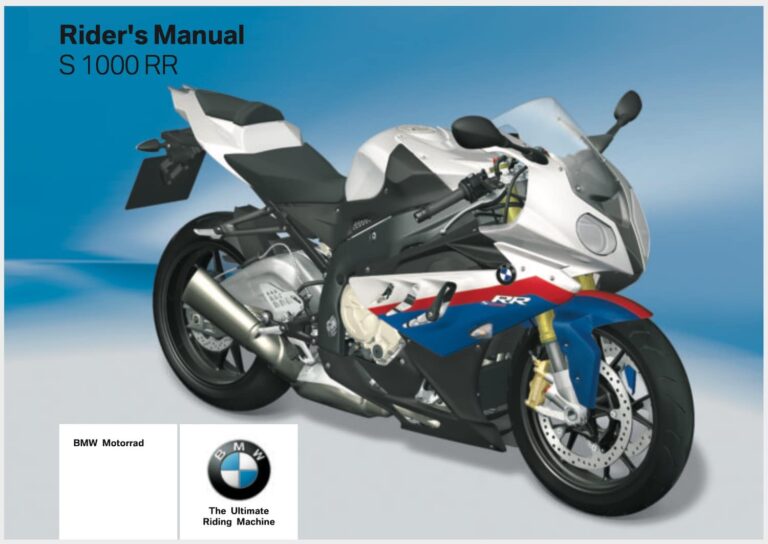
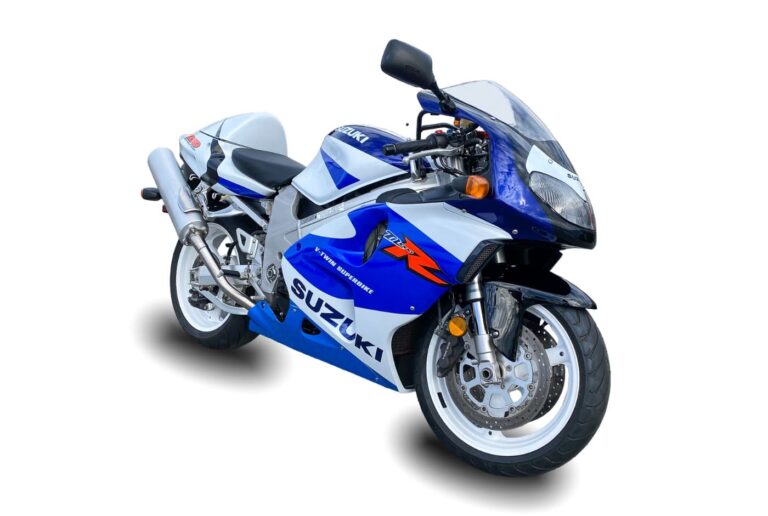
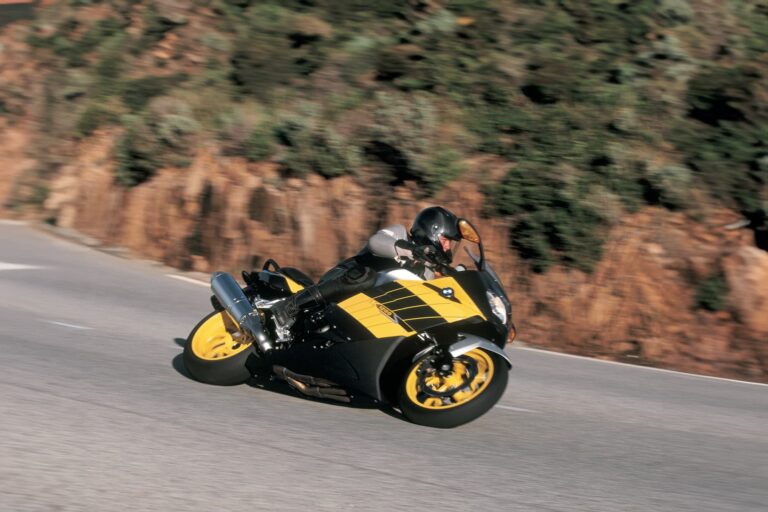
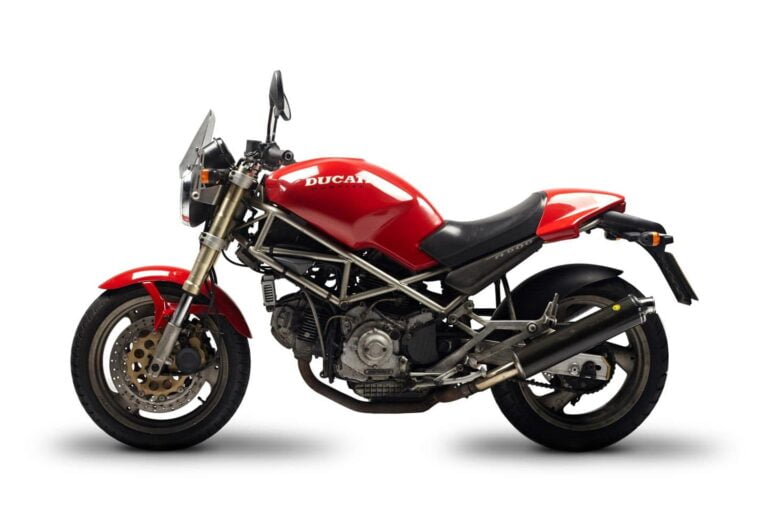
I own a zrx1200r. I love it. I do have a couple questions
Great article but there is no sixth gear on the ZRX1100 or 1200R model. Only the DAEG model got the sixth gear.
Yes, I meant to write top gear… I even had mentioned later that DAEG got the sixth gear! Thanks so much for helping me improve it.
I have a zrx 1200, love the bike,very easy and fun to ride,lots of power if you need it. Would like the 6 speed tranny, I know James Compton raced several of those bikes,he put six speed trannys on his,so it can be done.
I really like your site. This was an amazing review/history lesson.
The new 900rs really attracts me. I’m 62, so of course I remember the original.
I was riding a Yamaha RD350 at the time.
It would be a big bike for me (5’5” 130lbs).
But I owned a Yamaha xs750 back in the day, and rode it thru 2 crankshafts, And a defective 2nd gear.
I have the Z900RS Cafe, but I wouldn’t call it an Eddie Lawson replica. True, it’s the Kawasaki racing green color, and it has a bikini fairing, but there’s no blue stripe on it, and the body shape is all wrong. The RS Cafe is based off the standard RS, which is a replica of the original Z1, which is a bike that came out a full 10 years and 2 body styles before the ELR came out. I’m still a little torn, because it’s the wrong body shape, and doesn’t have all the ELR colors, and Kawasaki makes no mention of Eddie Lawson in reference to this bike, but Eddie HIMSELF was actually at the Cafe unveiling in California!
Good article and well researched. I own a 2018 green z900rs cafe and agree with most of your statements. (Mine has a blue stripe on the white body work as well!).
Point is that the rs is not a replica of the older models, it is a modern tribute and reminder of how far these bikes have come today. Ride them and admire them. They are so good compared to the 1972 and latter versions straight out of the box!
Hi
Really good item and nice description of the ZRX 1200 R which is a totally cool machine, it’s just so fucking annoying that you can not get them anymore .. but maybe you should take a trip to Japan and buy one .. I have for a long time would… so maybe it happens one day who knows
I even had a 2005 edition a few years back and yes ever since I sold it I have actually regretted and I am looking for one again so if anyone knows someone who does not want to own one more then say so …
At the moment I drive on my KZ 900 from 1976 or when it has to go a little faster then the trips are made on my ZX9R from 95… also a nice bike in my opinion and yes it is of course the Green / purple / white of them!
—
Hej
Rigtig god aktikel og lækker beskrivelse af ZRX 1200 R som er en total cool maskine, det er bare så skide ærgelig at man ikke kan få dem mere .. men måske man skulle tage en tur til Japan og købe en .. det har jeg længe ville … så måke det sker en dag hvem ved
Jeg havde selv en 2005 udgave et par år tilbage og ja lige siden jeg solgte den har jeg faktisk fortrudt og jeg søger så en igen så hvis nogen kender nogen som ikke vil eje sådan en mere så sig til …
Pt køre jeg så videre på min KZ 900 fra 1976 eller når det skal gå lidt hurtugere så bliver turene tilbagelagt på min ZX9R fra 95 … også en flot cykel efter min mening og ja det er selvfølgelig den Grøn/lilla/hvide af dem!
Thank you Anders!
All — if anyone in Denmark wants to sell a ZRX1200R, let me know and I’ll put you in touch.
A question for the pros please. I now own a 1999 elr zrx 1100. I am just learning exactly what i have. I love the bike and have been told it is not stock. Upgrades in the pistons camshaft and possibly more. It is fast. I have read of common problems with the gears. With mine it is fourth gear. I thought maybe broken teeth or cogs on the gear but now im thinking it could be just the shift fork is bent a little. I can run in fourth gear as long as im easing along. Its seems very normal but if i try to accelerate too quick then its seems as tho the gear is stripped. It just seems to me like if it were teeth broke on that gear it would do it even when im easing along. Does that sound correct?? Any help or advice is appreciated. I love this bike tho and it is here to stay.
One of my regular riding crew friends has a green ZRX1200R. Since I ride a Z900RS, we like to compare our inline fours. We agree that some characteristics just have a “kawasaki feel” to them in terms of the power delivery and torque. Mine seems to feel lighter, though, and is more comfortable for long distance touring. The two bikes always look fantastic parked together, even though mine is the original orange and brown paint scheme.
That’s really unique that you can compare them back to back like that. If you have pics of them together, email them in to info@ ! Just for my own enjoyment, though of course I may ask for permission to publish. Cool looking jewelry brand by the way.